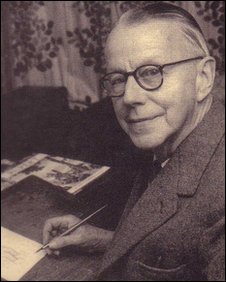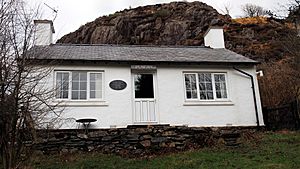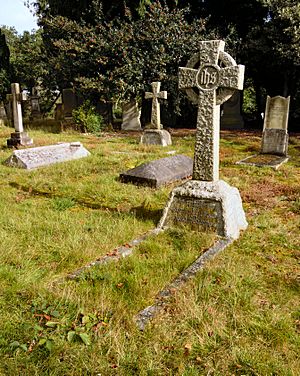Alfred Bestall facts for kids
Quick facts for kids
Alfred Bestall (MBE)
|
|
|---|---|
 |
|
| Born |
Alfred Edmeades Bestall
14 December 1892 |
| Died | 15 January 1986 (aged 93) Porthmadog, Wales
|
| Education | Birmingham School of Art, Central School of Art and Design |
| Occupation | Writer, cartoonist, illustrator, origamist |
| Known for | Rupert Bear |
| Honours | Blue plaque |
Alfred Edmeades "Fred" Bestall, MBE (born December 14, 1892 – died January 15, 1986) was a talented writer and artist. He is best known for creating the popular Rupert Bear stories. He wrote and drew these adventures for the London Daily Express newspaper from 1935 to 1965.
Biography
Early Life and Education
Alfred Bestall was born in 1892 in Mandalay, which is in Burma. His parents were missionaries. When he was five years old, he and his sister moved to England. His parents joined them later in 1910.
Alfred went to Rydal Mount school in Colwyn Bay from 1904 to 1911. He was very good at art and won a scholarship to the Birmingham School of Art. He also studied at the Central School of Arts and Crafts in London.
During World War I, Alfred served in the British Army. He was a driver, transporting soldiers and supplies in places like Flanders. He often drove large vehicles, like converted London buses, even when there was danger from enemy fire.
Working as an Artist
After the war, Bestall finished his art studies. He soon began illustrating books for famous authors like Enid Blyton. He also drew pictures for well-known magazines such as Punch and Tatler. Over his career, he illustrated more than 50 books.
In 1935, Alfred Bestall was chosen to take over the Rupert Bear comic strip. The original artist, Mary Tourtel, was no longer able to draw the stories. Bestall had to learn about Rupert quickly. He said he bought the Daily Express to study Mary Tourtel's simple drawing style. For the first 12 years, he didn't sign his Rupert strips out of respect for her.
Bestall had only five weeks to prepare his first Rupert story. It was called 'Rupert, Algy and the Smugglers' and appeared on June 28, 1935. He made the Rupert stories even better with exciting plots and beautiful drawings. Many of the landscapes in Rupert's world were inspired by the Snowdonia area in North Wales. Bestall loved this area, especially around Beddgelert.
He was often asked where Rupert's home village, Nutwood, was located. Bestall explained that it was a mix of different places. It combined the wooded areas of Kent and Sussex with the Severn Valley near Hereford. It also included the rugged mountains of Snowdonia. The Children's Editor at the Daily Express gave Bestall one main rule: "no evil characters, fairies or magic."
During World War II, Bestall also helped as an air raid warden in Surbiton, England. He even painted a picture of his air-raid post in the snow, which was shown at the Royal Academy of Arts. This was one of his proudest achievements.
Alfred Bestall drew his last daily Rupert story on July 22, 1965. He retired from the Daily Express that same month. However, he continued to create the covers and special endpapers for the Rupert annual books until 1973.
Personal Life
Alfred Bestall had a severe stutter when he was younger. This made him very shy. He believed it was caused by a spinal injury he had as a baby in Burma. When he was 45, he saw a specialist who helped him. After that, his stutter was cured!
Bestall never had children of his own. But when asked if he regretted this, he said he felt like he had "thousands of them" because of all his young readers.
Even though he lived in Surbiton, he loved to holiday in Nant Gwynant, near Beddgelert in Wales. In 1956, he bought a cottage there and named it 'Penlan'. This cottage, with its amazing views, became his permanent home in 1980.
Bestall was also very interested in origami, the art of paper folding. He often included origami models in the Rupert Annuals, starting in 1946. He helped make origami popular in the UK. He was even the president of the British Origami Society for many years until he passed away.
In 1985, Alfred Bestall was made a Member of the Order of the British Empire (MBE). This is a special award from the Queen for his contributions. He couldn't receive it in person because he was ill. On his 93rd birthday, Prince Charles sent him a message, congratulating him and saying he remembered Bestall's wonderful Rupert Bear illustrations from his own childhood.
Alfred Bestall passed away on January 15, 1986, at the age of 93. He is buried in Brookwood Cemetery. In 2006, a blue plaque was placed on his former home in Surbiton to remember him.
Documentary
A documentary called The Rupert Bear Story was shown on Channel 4 on December 9, 1982. It was directed by Terry Jones, who was a member of the comedy group Monty Python. Rupert Bear was his favorite children's story.



